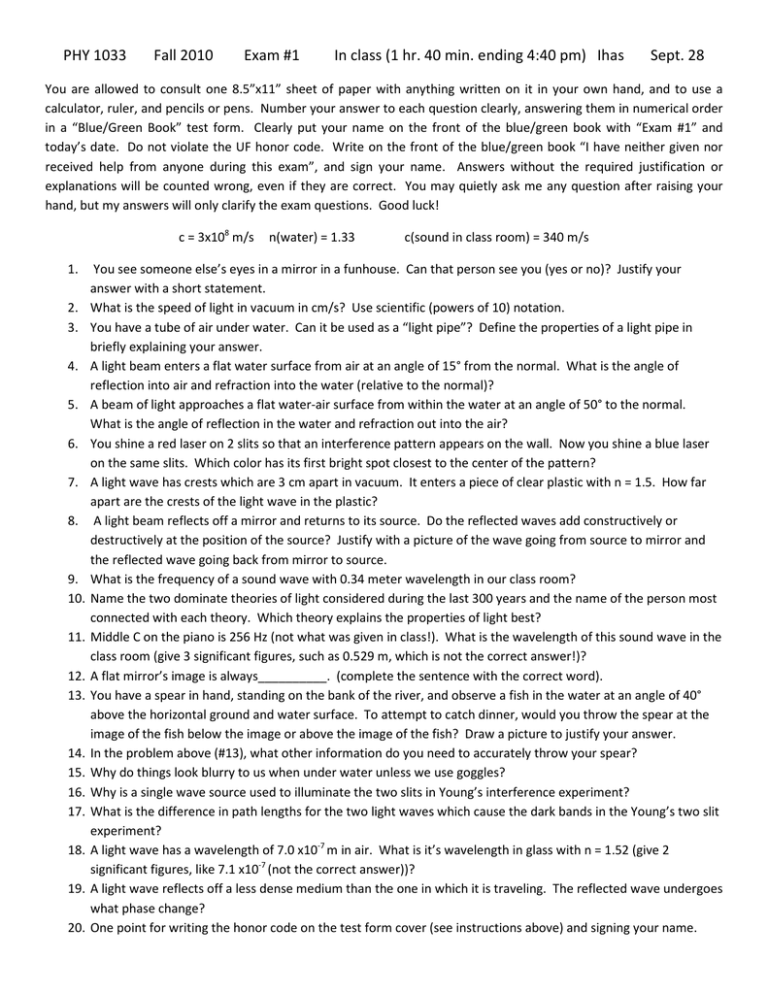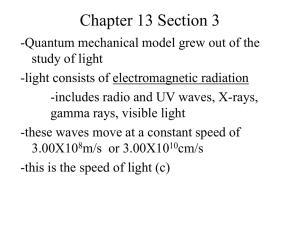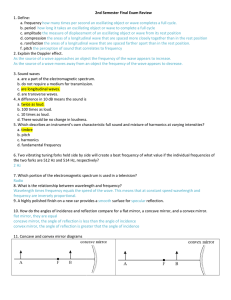PHY 1033 Fall 2010 Exam #1
advertisement

PHY 1033 Fall 2010 Exam #1 In class (1 hr. 40 min. ending 4:40 pm) Ihas Sept. 28 You are allowed to consult one 8.5”x11” sheet of paper with anything written on it in your own hand, and to use a calculator, ruler, and pencils or pens. Number your answer to each question clearly, answering them in numerical order in a “Blue/Green Book” test form. Clearly put your name on the front of the blue/green book with “Exam #1” and today’s date. Do not violate the UF honor code. Write on the front of the blue/green book “I have neither given nor received help from anyone during this exam”, and sign your name. Answers without the required justification or explanations will be counted wrong, even if they are correct. You may quietly ask me any question after raising your hand, but my answers will only clarify the exam questions. Good luck! c = 3x108 m/s 1. 2. 3. 4. 5. 6. 7. 8. 9. 10. 11. 12. 13. 14. 15. 16. 17. 18. 19. 20. n(water) = 1.33 c(sound in class room) = 340 m/s You see someone else’s eyes in a mirror in a funhouse. Can that person see you (yes or no)? Justify your answer with a short statement. What is the speed of light in vacuum in cm/s? Use scientific (powers of 10) notation. You have a tube of air under water. Can it be used as a “light pipe”? Define the properties of a light pipe in briefly explaining your answer. A light beam enters a flat water surface from air at an angle of 15° from the normal. What is the angle of reflection into air and refraction into the water (relative to the normal)? A beam of light approaches a flat water-air surface from within the water at an angle of 50° to the normal. What is the angle of reflection in the water and refraction out into the air? You shine a red laser on 2 slits so that an interference pattern appears on the wall. Now you shine a blue laser on the same slits. Which color has its first bright spot closest to the center of the pattern? A light wave has crests which are 3 cm apart in vacuum. It enters a piece of clear plastic with n = 1.5. How far apart are the crests of the light wave in the plastic? A light beam reflects off a mirror and returns to its source. Do the reflected waves add constructively or destructively at the position of the source? Justify with a picture of the wave going from source to mirror and the reflected wave going back from mirror to source. What is the frequency of a sound wave with 0.34 meter wavelength in our class room? Name the two dominate theories of light considered during the last 300 years and the name of the person most connected with each theory. Which theory explains the properties of light best? Middle C on the piano is 256 Hz (not what was given in class!). What is the wavelength of this sound wave in the class room (give 3 significant figures, such as 0.529 m, which is not the correct answer!)? A flat mirror’s image is always__________. (complete the sentence with the correct word). You have a spear in hand, standing on the bank of the river, and observe a fish in the water at an angle of 40° above the horizontal ground and water surface. To attempt to catch dinner, would you throw the spear at the image of the fish below the image or above the image of the fish? Draw a picture to justify your answer. In the problem above (#13), what other information do you need to accurately throw your spear? Why do things look blurry to us when under water unless we use goggles? Why is a single wave source used to illuminate the two slits in Young’s interference experiment? What is the difference in path lengths for the two light waves which cause the dark bands in the Young’s two slit experiment? A light wave has a wavelength of 7.0 x10-7 m in air. What is it’s wavelength in glass with n = 1.52 (give 2 significant figures, like 7.1 x10-7 (not the correct answer))? A light wave reflects off a less dense medium than the one in which it is traveling. The reflected wave undergoes what phase change? One point for writing the honor code on the test form cover (see instructions above) and signing your name.







